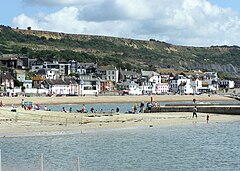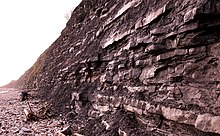Lyme Regis
| Lyme Regis | |
|---|---|
 Lyme Regis from the Cobb | |
| Population | 4,406 [1] |
| OS grid reference | SY337922 |
| • London | 130 Miles (209 Km) |
| District | |
| Shire county | |
| Region | |
| Country | England |
| Sovereign state | United Kingdom |
| Police | Dorset |
| Fire | Dorset and Wiltshire |
| Ambulance | South Western |
Lyme Regis is a coastal town in West Dorset, England, 25 miles west of Dorchester and 25 miles (40 km) east of Exeter. The town lies in Lyme Bay, on the English Channel coast at the Dorset-Devon border. It is nicknamed 'The Pearl of Dorset'.
The town is noted for the fossils found in the cliffs and beaches, which are part of the Jurassic Coast–a World Heritage Site. The harbour wall, "The Cobb", features in Jane Austen's novel Persuasion, and in the movie and novel, The French Lieutenant's Woman, by local writer John Fowles.
When people were counted in the town's most recent census in 2001, the population was 4,406. 45% of the town's population were retired people.[2]
Geology
[change | change source]
The town is noted for the fossils found in the cliffs and beaches, which are part of the Jurassic Coast–a World Heritage Site. The Jurassic Coast stretches over a distance of 153 kilometres (95 mi).[3]
The coastal exposures along the coastline provide a continuous sequence of Triassic, Jurassic and Cretaceous rock formations spanning approximately 185 million years of the Earth's history. The localities along the Jurassic Coast include some important fossil zones. The Blue Lias rock is host to a multitude of remains from the early Jurassic, a time from which good fossil records are rare.[4] Many of the remains are well preserved, with complete specimens of several important species. Many of the earliest discoveries of dinosaur and other prehistoric reptile remains were made in the area surrounding Lyme Regis, notably those discovered by Mary Anning (1799–1847). Significant finds include Ichthyosaur, Plesiosaur, Dimorphodon, Scelidosaurus, one of the first armoured (Thyreophora) dinosaurs. The town now holds an annual Mary Anning Day and Lyme Regis Fossil Festival. A fossil of the world's largest moth was discovered in 1966 at Lyme Regis.
Landslips
[change | change source]
The coastal region near Lyme Regis is subject to large landslips. This means that Jurassic age fossils are regularly exposed and can be found on the beaches, but also causes devastation to the town.[5]
One of the most spectacular landslips occurred on 24 December 1839, 3 miles (4.8 km) west along the coast in Devon belonging to Bindon Manor and known as "The Dowlands Landslip". About 45 acres (18 ha) of fields growing wheat and turnips were dislodged when a great chasm was formed more than 300 feet (91 m) across, 160 feet (49 m) deep and 0.75 miles (1.21 km) long. The crops remained intact on the top of what became known as "Goat Island" among the newly formed gullies. On 3 February 1840, five weeks later, there was a second landslip nearby but much smaller than the former. This strange phenomenon attracted many visitors, and the canny farmers charged sixpence for entrance and held a grand reaping party when the wheat ripened.[6] The area is now known as The Undercliff and is of great interest because of its diverse natural history.
In 2005, work began on a £16 million engineering project to stabilise the cliffs and protect the town from coastal erosion.[7] The town's main beach was reconstructed and re-opened on 1 July 2006. On the evening of 6 May 2008, a 400 metres (1,300 ft) section of land slipped onto the beach between Lyme Regis and Charmouth. Local Police described the landslip as the "worst for 100 years".[8]
References
[change | change source]- ↑ Census 2001
- ↑ Office for National Statistics, 2001. Census data Archived 2006-01-03 at the Wayback Machine.
- ↑ "Dorset and East Devon Coast". UNESCO World Heritage Centre. 2001. Retrieved 2007-01-14.
- ↑ Benton MJ, Spencer PS (1995). Fossil reptiles of Great Britain. Chapman & Hall. ISBN 0-412-62040-5.
- ↑ "Town fears more landslides". BBC News England. 8 January 2003. Retrieved 2006-07-05.
- ↑ The Undercliff. Archived 2006-09-02 at the Wayback Machine Philpot Museum website, Lyme Regis. Accessed 2006-09-01.
- ↑ "Popular beach reopens for summer". BBC News. 1 July 2005. Retrieved 2006-07-05.
- ↑ "Landslip is 'worst in 100 years". BBC News. 7 May 2008. Retrieved 2008-05-07. [Includes video]
